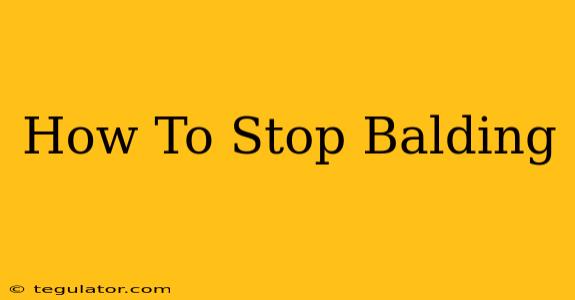Balding, or androgenetic alopecia, is a common condition affecting millions worldwide. While it's often associated with aging, it can start as early as your teens or twenties. Fortunately, there are several ways to slow down or even stop hair loss, depending on the cause and severity. This comprehensive guide will explore various effective methods to help you combat balding and regain a fuller head of hair.
Understanding the Causes of Balding
Before diving into solutions, understanding the root cause of your hair loss is crucial. Several factors can contribute to balding, including:
- Genetics: This is the most common cause. A family history of balding significantly increases your risk.
- Hormonal Changes: Fluctuations in hormone levels, particularly androgens like DHT (dihydrotestosterone), can shrink hair follicles, leading to thinning hair.
- Nutritional Deficiencies: Lack of essential vitamins and minerals like iron, zinc, and biotin can negatively impact hair growth.
- Medical Conditions: Certain medical conditions like thyroid disorders, autoimmune diseases, and scalp infections can contribute to hair loss.
- Stress: Chronic stress can disrupt the hair growth cycle, leading to temporary or even permanent hair loss.
- Medications: Some medications have hair loss as a side effect.
- Harsh Hair Styling: Tight hairstyles, excessive heat styling, and chemical treatments can damage hair follicles.
Proven Methods to Stop Balding
While a complete cure for balding isn't always possible, various methods can significantly slow down hair loss and even promote regrowth. These include:
1. Medications:
- Minoxidil (Rogaine): This over-the-counter topical solution is FDA-approved to treat androgenetic alopecia. It stimulates hair growth and slows down hair loss.
- Finasteride (Propecia): A prescription oral medication, Finasteride, blocks the production of DHT, thereby reducing hair loss and promoting regrowth. Important Note: Consult your doctor before taking Finasteride, as it has potential side effects.
2. Hair Transplant Surgery:
For more advanced hair loss, a hair transplant is a surgical option. This procedure involves moving hair follicles from a donor area (usually the back of the head) to the balding areas. Results are permanent, but it's a significant investment.
3. Lifestyle Changes:
- Healthy Diet: A balanced diet rich in protein, vitamins, and minerals is crucial for healthy hair growth. Focus on foods like lean protein, fruits, vegetables, and whole grains.
- Stress Management: Practice stress-reducing techniques like yoga, meditation, or regular exercise.
- Gentle Hair Care: Avoid harsh chemicals, excessive heat styling, and tight hairstyles. Use gentle shampoos and conditioners.
4. Platelet-Rich Plasma (PRP) Therapy:
PRP therapy involves injecting your own platelet-rich plasma into your scalp to stimulate hair follicle growth. It's a minimally invasive procedure with promising results for some individuals.
5. Low-Level Laser Therapy (LLLT):
LLLT uses low-level lasers to stimulate hair follicles and promote growth. This treatment can be done at home with devices or in a clinic.
When to See a Doctor
If you're experiencing significant hair loss, it's essential to consult a dermatologist or trichologist. They can diagnose the underlying cause of your hair loss and recommend the most appropriate treatment plan. Early intervention is crucial for maximizing the chances of successful treatment.
Conclusion: Taking Control of Your Hair Loss
Balding can be distressing, but understanding the causes and exploring available treatment options can empower you to take control. Remember that patience and consistency are key. By adopting a holistic approach that combines medication, lifestyle changes, and potentially other therapies, you can significantly improve your chances of slowing down or stopping balding and achieving a fuller, healthier head of hair. Don't hesitate to seek professional help to determine the best course of action for your individual needs.

